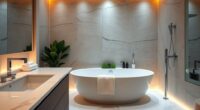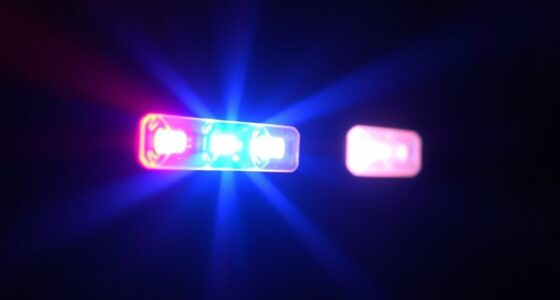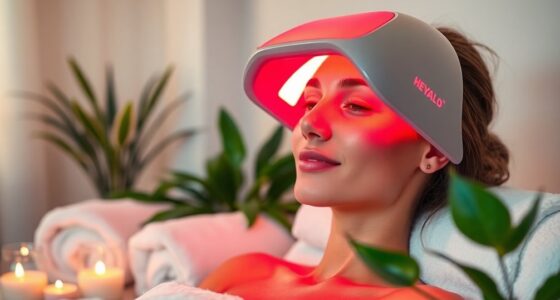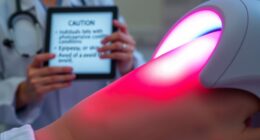Blue-light therapy is backed by science as an effective tool for regulating sleep schedules by syncing your internal clock with natural light patterns. It helps reset circadian rhythms, especially for those with delayed sleep phase or jet lag, when used correctly at the right times. However, improper or late-day exposure can suppress melatonin and worsen sleep problems. When applied properly, blue-light therapy can improve sleep quality and daytime function—continue exploring to understand how to use it safely.
Key Takeaways
- Blue-light therapy can realign circadian rhythms and improve sleep when used at appropriate times, supporting its scientific basis.
- Incorrect timing, especially evening exposure, can suppress melatonin and worsen sleep problems, highlighting the need for proper use.
- The therapy influences light-sensitive retinal cells that regulate the brain’s circadian clock, demonstrating a biological mechanism.
- It is effective for certain sleep disorders like delayed sleep phase and jet lag when guided by professionals.
- Misuse or overexposure at night may hinder sleep, so scientific application requires careful timing and expert advice.

Blue-light therapy has emerged as a promising approach for managing sleep disorders by helping regulate your body’s internal clock. This method primarily targets your circadian rhythms, the natural 24-hour cycle that influences sleep-wake patterns, hormone production, and alertness levels. When your circadian alignment is disrupted—due to shift work, jet lag, or irregular sleep schedules—your body struggles to produce melatonin at the right times, leading to difficulty falling asleep or staying asleep. Blue light, especially in the morning, can help reset this cycle, encouraging your internal clock to synchronize with the day-night pattern.
However, while blue-light therapy can be beneficial, it also carries risks if misused. Exposure to blue light in the evening can cause melatonin suppression, which is the hormone responsible for signaling your body to prepare for sleep. When melatonin levels drop prematurely, you may find it harder to fall asleep or experience lighter, less restorative sleep. That’s why timing is vital; using blue-light therapy during the morning or early afternoon can promote circadian alignment by signaling to your brain that it’s daytime, helping you wake up feeling more alert. Conversely, exposing yourself to blue light late in the day can disrupt your natural melatonin production, making it difficult to wind down at night.
The science behind blue-light therapy is rooted in its ability to influence light-sensitive cells in your eyes called intrinsically photosensitive retinal ganglion cells (ipRGCs). These cells send signals to the brain’s master clock, the suprachiasmatic nucleus, which regulates melatonin secretion. When you expose yourself to blue light at appropriate times, you reinforce your body’s natural rhythm. This can be especially helpful for individuals with delayed sleep phase disorder, where their internal clock runs late, or for those experiencing jet lag. Proper use of blue-light therapy can help align your circadian rhythm with your desired sleep schedule, improving sleep quality and daytime functioning.
Nevertheless, it’s vital to understand that blue-light therapy isn’t a one-size-fits-all fix. Misapplication, such as using high-intensity blue light at night, can exacerbate sleep problems by causing excessive melatonin suppression. Always consider the timing and duration of exposure. Consulting with a sleep specialist can ensure you’re using blue-light therapy effectively, maximizing its benefits while minimizing potential setbacks. When used correctly, blue-light therapy can be a powerful tool to help you achieve better circadian alignment and improve your overall sleep health.
Frequently Asked Questions
Can Blue-Light Therapy Replace Traditional Sleep Medications?
Blue-light therapy isn’t likely to fully replace traditional sleep medications, but it can serve as a helpful alternative or complement. You should focus on behavioral adjustments like maintaining a consistent sleep schedule, reducing screen time before bed, and managing stress. While blue-light therapy may improve circadian rhythms, it’s important to consult a healthcare provider to determine if it’s a suitable medication alternative for your specific sleep issues.
Is Blue-Light Therapy Effective for All Types of Sleep Disorders?
Blue-light therapy isn’t effective for all sleep disorders, especially if you have light sensitivity issues or disrupted circadian alignment. Studies show it benefits conditions like delayed sleep phase syndrome but may worsen symptoms in others. If your disorder involves irregular sleep-wake cycles, blue light can help reset your internal clock. However, it’s essential to consult a healthcare professional to determine if it’s suitable for your specific condition.
How Long Does It Take to See Results From Blue-Light Therapy?
You can typically expect to see results from blue-light therapy within one to two weeks, but timing expectations vary due to individual variability. Some people notice improvements sooner, while others may need several weeks of consistent use. To maximize benefits, stick to a regular schedule and follow your healthcare provider’s advice. Patience is key, as your response depends on your unique sleep patterns and how your body reacts to the therapy.
Are There Any Age Restrictions for Blue-Light Therapy?
There are age limitations for blue-light therapy, especially with pediatric considerations in mind. Typically, it’s not recommended for very young children due to their developing eyes and potential sensitivity. For adolescents and adults, it’s generally safe when supervised by a healthcare professional. Always consult a specialist to evaluate age restrictions and make certain the therapy aligns with your specific health needs, especially for minors or those with eye sensitivities.
Can Blue-Light Therapy Be Combined With Other Sleep Treatments?
You can definitely combine blue-light therapy with other sleep treatments, as combining therapies often enhances effectiveness. Many find that using blue-light therapy alongside behavioral changes, medication, or relaxation techniques works as complementary approaches, addressing different aspects of sleep issues. Just make sure to consult your healthcare provider to develop a personalized plan, ensuring these treatments work together safely and effectively for your specific sleep disorder.
Conclusion
Think of blue-light therapy as a guiding lighthouse, shining its steady beam through the fog of sleep disorders. When used correctly, it can help you navigate toward restful nights and clear mornings. But if you ignore its signals or misuse its light, you risk wandering aimlessly in darkness. Like any lighthouse, its power lies in understanding when and how to use it. So, steer wisely, and let blue light help you find your way back to peaceful sleep.









